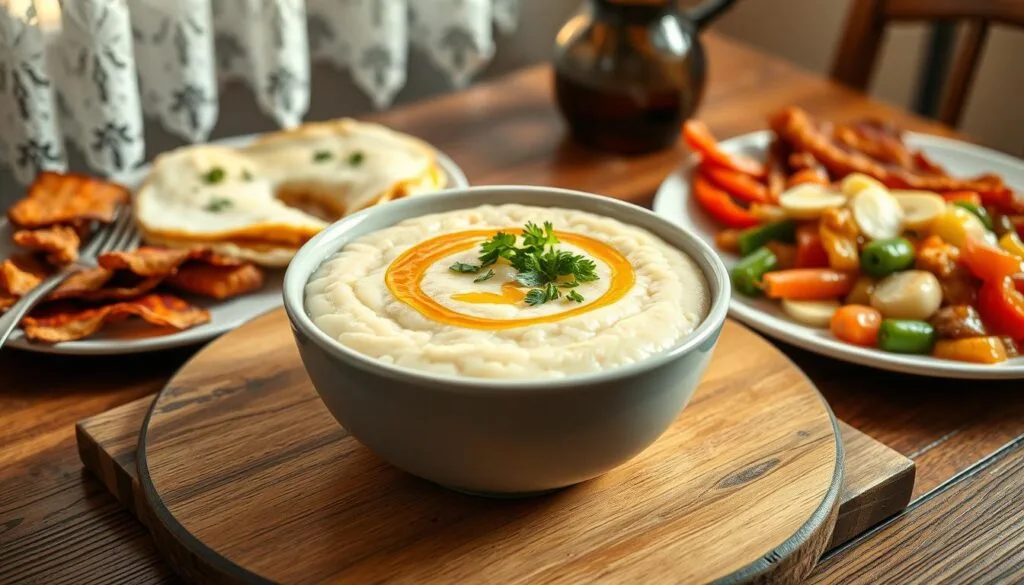Every morning, the smell of warm spanish grits fills my kitchen. It takes me back to my family’s cooking traditions. The creamy texture of maiz pelado tells stories of comfort and connection.
It invites you to try a breakfast that’s more than food. It’s a celebration of flavor and heritage.
Spanish grits, or gachas de maíz, are more than a simple dish. They’re a canvas of culinary creativity. They mix rich traditions with modern tastes.
Whether you’re looking for a hearty breakfast or a comforting meal, these grits offer a delightful journey. They take you through Spanish breakfast culture.
Table of Contents
Key Takeaways
- Spanish grits offer a unique breakfast experience
- Maiz pelado provides rich, creamy texture
- Gachas de maíz connects traditional and modern cuisine
- Versatile dish adaptable to various flavor profiles
- Simple ingredients create extraordinary meals
Understanding Spanish Grits: A Cultural Breakfast Staple
Spanish Grits, or desayuno de gachas españolas, is a beloved breakfast dish in Spain. It has a long history, shaped by many cultures. This dish combines flavors and cooking styles from different backgrounds.
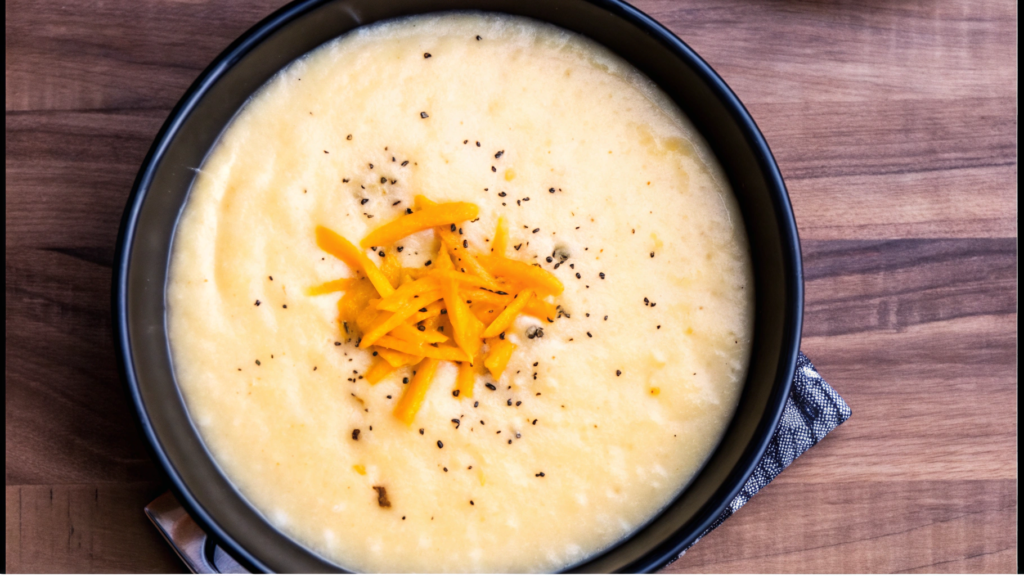
The story of Spanish Grits is one of culinary creativity. It has ties to Indigenous, European, and West African cooking. This blend of traditions makes it unique.
Origins and Preparation Methods
Spanish Grits are made using ancient corn-milling techniques. The traditional way includes:
- Slow-cooking ground corn kernels
- Using stone-ground cornmeal
- Incorporating regional spices and herbs
- Cooking in traditional clay pots
Cultural Significance in Spanish Cuisine
Spanish Grits are more than food; they represent community and heritage. They connect families across generations. The simple yet meaningful way they are made is a testament to this.
| Region | Unique Preparation Style | Key Ingredients |
|---|---|---|
| Andalusia | Creamy texture | Olive oil, sea salt |
| Catalonia | Thick consistency | Local herbs, garlic |
| Basque Country | Smooth blend | Butter, local cheese |
Regional Variations Across Spain
Every region in Spain adds its own twist to making grits. From the coast to the mountains, each area’s grits reflect its local tastes and traditions.
- Northern Spain: Heartier, more robust preparations
- Mediterranean Coast: Lighter, with more herbs
- Central Spain: Traditional, minimalist approach
Essential Ingredients for Authentic Spanish Grits
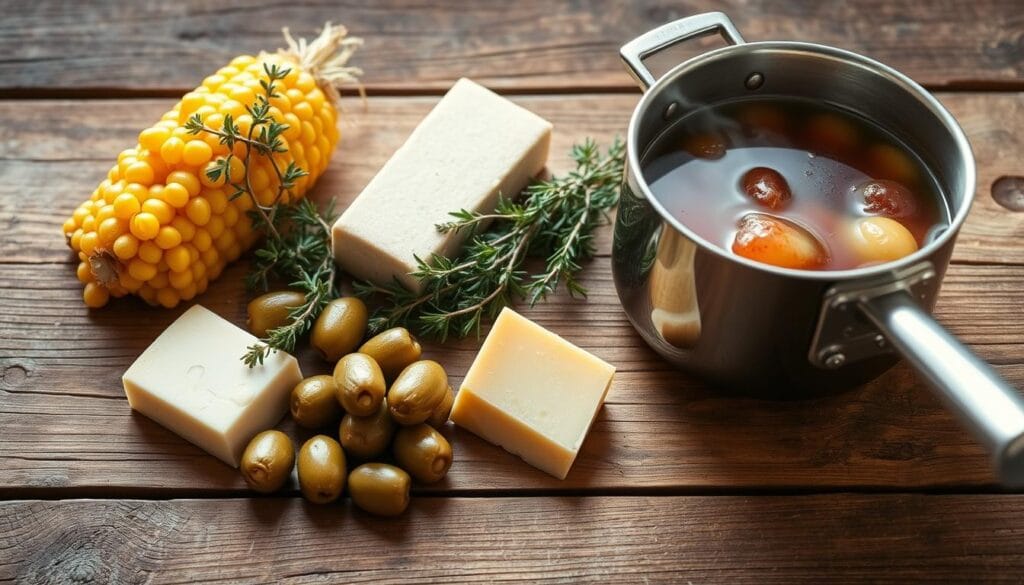
Making tasty gachas españolas con caldo begins with picking the right ingredients. The base of authentic Spanish grits is high-quality corn. It’s mixed with special seasonings that add deep, rich flavors.
To get that perfect Spanish taste, your masa de granos de maíz cocida needs certain ingredients. Here are the main ones:
- Corn Base: Stone-ground corn kernels (preferably yellow corn for a slightly sweeter profile)
- High-quality chicken or vegetable stock
- Fresh unsalted butter
- Half-and-half cream
- Salt and freshly ground black pepper
The quality of your corn is key. Stone-ground grits keep kernel bits, adding flavor and texture. Yellow corn gives a sweet taste that makes the dish better.
Traditional Spanish recipes use local spices for depth. Try adding:
- Smoked paprika
- Dried thyme
- Minced garlic
- Extra virgin olive oil
Pro tip: Use fresh, high-quality ingredients for authentic gachas españolas con caldo. The right mix of ingredients turns simple corn grits into a memorable Spanish breakfast.
Kitchen Tools and Equipment Needed
To make authentic polenta española, you need the right tools. The right equipment makes cooking smooth and the results delicious.
Traditional Cookware Options
Old-school Spanish kitchens use special pots for grits. Ceramic and copper pots have been favorites for making creamy polenta española for years.
- Ceramic clay pots (traditional)
- Copper cooking vessels
- Cast-iron Dutch ovens
- Wooden spoons for stirring
Modern Kitchen Alternatives
Today, we have easier ways to make puré de maíz ibérico. Non-stick pans and electric gadgets make cooking grits simpler.
- Non-stick large saucepans
- Instant Pot or multicookers
- Silicone spatulas
- Electric whisks
Storage Solutions
Keeping your polenta española fresh is key. Use good containers to keep your ingredients and cooked grits fresh.
| Storage Type | Best For | Duration |
|---|---|---|
| Airtight Glass Containers | Dry Corn Meal | 6-12 months |
| Sealed Plastic Containers | Cooked Grits | 3-5 days |
| Freezer Bags | Leftover Grits | 1-2 months |
Pro tip: Always label your containers with the date of storage to track freshness and prevent waste.
Step-by-Step Cooking Instructions
Cooking Spanish grits, also known as gachas, needs precision and patience. Unlike Mexican dishes like pozole, these grits require careful steps for the perfect creamy texture.
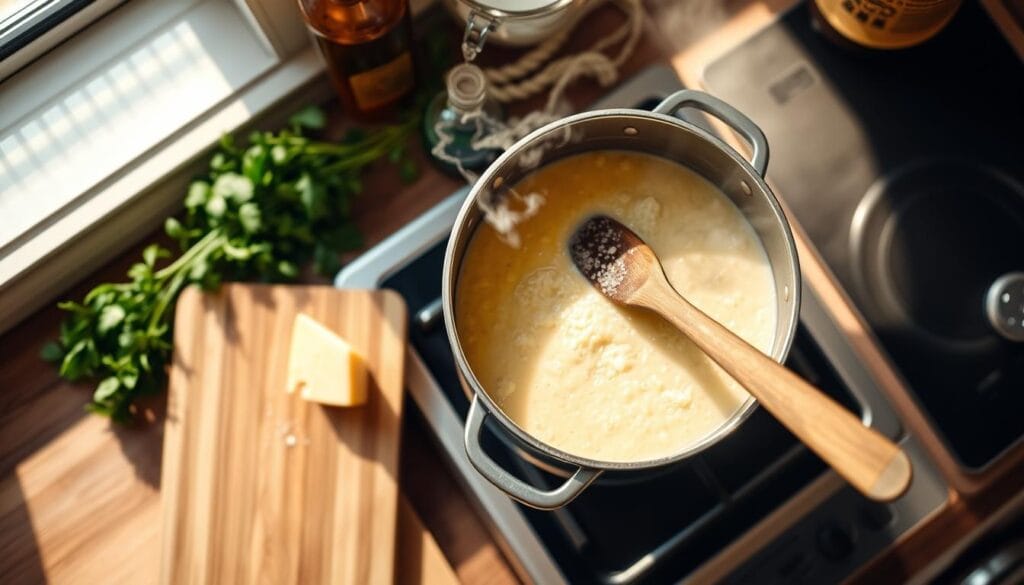
First, gather your ingredients and tools. To make Spanish grits, follow these key steps:
- Measure your ingredients precisely
- 1 cup stone-ground grits
- 3 cups water
- 1 tablespoon olive oil
- Salt to taste
- Prepare your cooking surface
- Use a heavy-bottomed pot
- Set to medium-low heat
The cooking process for Spanish grits takes about 20-25 minutes. Stir constantly to avoid lumps and get a smooth texture.
| Cooking Stage | Duration | Key Action |
|---|---|---|
| Initial Boiling | 5 minutes | Bring water to simmer |
| Grits Incorporation | 15-20 minutes | Continuous stirring |
| Final Seasoning | 2-3 minutes | Add salt and olive oil |
Pro tip: The Mexican equivalent of grits is often corn-based dishes like pozole. But Spanish grits have their own special way of being made, making them different from other regional dishes.
Mastering the Perfect Consistency
Getting the right texture for Spanish grits takes skill and focus. Knowing the difference between polenta and grits helps you make them creamy and smooth.
The perfect grits consistency comes from a few important factors. Unlike polenta, which is made from cornmeal, grits have a special texture. This texture needs careful preparation to get right.
Troubleshooting Common Texture Issues
- Lumpy Texture: Whisk continuously while adding grits to hot liquid
- Too Thick: Add warm milk or broth to thin the mixture
- Too Thin: Continue cooking or add more grits gradually
- Grainy Feel: Use stone-ground grits for smoother results
Pro Tips for Creamy Results
Even though grits aren’t common in Mexico, they’re similar to other corn dishes. For a luxurious texture, follow these expert tips:
- Use a 4:1 liquid-to-grits ratio
- Cook on low heat for 15-20 minutes
- Stir frequently to prevent sticking
- Finish with butter or cream for extra smoothness
| Texture Problem | Solution |
|---|---|
| Watery Grits | Simmer uncovered to reduce liquid |
| Undercooked Grits | Add more hot liquid, continue cooking |
| Overcooked Grits | Rescue with additional cream or milk |
Remember, practice makes perfect when mastering the art of creating creamy, delectable Spanish grits!
Spanish Grits Base Recipe
Explore the world of Spanish grits, a tasty breakfast dish. It combines old flavors with new cooking methods. Knowing the types of grits is key for a real Spanish dish. In Spanish, grits are called “gachas” or “sémola de maíz,” adding a local twist.
- Stone-ground grits: Coarsely ground with a robust texture
- Quick grits: Processed for faster cooking
- Instant grits: Pre-cooked and dehydrated for immediate use
Here’s a simple recipe for tasty Spanish-style grits:
| Ingredient | Quantity |
|---|---|
| Lean Chorizo | 4 ounces |
| Quick 5-minute Grits | 1 cup |
| Chicken Broth/Stock | 4 cups |
| Eggs | 4 |
Cooking Instructions:
- Prepare chicken broth in a large saucepan
- Slowly whisk in grits
- Cook for approximately 5 minutes
- Brown chorizo in a separate pan
- Combine chorizo with prepared grits
- Top with a fried egg
Nutrition Highlights: • Calories per serving: 236 • Protein: 14g • Carbohydrates: 30g • Total Fat: 7g
Pro tip: Add scallions, cilantro, or avocado to make your Spanish grits better. The secret is to mix flavors right and keep it creamy.
Flavorful Toppings and Add-ins
Make your spanish grits even better with tasty toppings. These toppings turn this classic dish into a masterpiece. Choose from traditional or modern options to find the perfect topping for your gachas de maíz.
Traditional Spanish Garnishes
Authentic Spanish grits shine with classic toppings. These toppings respect old culinary traditions. Here are some great choices:
- Crispy jamón ibérico crumbles
- Finely chopped hard-boiled eggs
- Olive oil drizzle
- Smoked paprika sprinkle
- Roasted garlic chunks
Modern Fusion Options
For those who love trying new things, modern toppings can make traditional grits exciting. Here are some options:
- Truffle-infused mushroom medley
- Spicy chorizo crumbles
- Manchego cheese shavings
- Roasted vegetables
- Herb-infused olive oil
Try these toppings to make your maiz pelado special. It will be a dish that excites your taste buds and brings Spanish cuisine to your home.
Serving Suggestions and Pairings
Spanish grits are a blank canvas for a delicious Spanish breakfast. They can turn a simple meal into a feast with the right toppings and pairings.
Here are some great ways to make your Spanish grits breakfast even better:
- Traditional Spanish Protein Pairings:
- Chorizo sausage
- Serrano ham
- Poached eggs
- Fresh Accompaniments:
- Sliced tomatoes with olive oil
- Roasted peppers
- Pan con tomate (tomato bread)
Choose drinks that match the flavors of your Spanish grits for a complete meal.
| Beverage | Pairing Notes |
|---|---|
| Spanish Coffee | Strong, dark roast to balance creamy grits |
| Fresh Orange Juice | Bright citrus cuts through richness |
| Cava | Sparkling wine for weekend brunch |
Don’t forget about presentation. Serve your Spanish grits in warm ceramic bowls. This keeps them hot and adds to the dining experience. Add fresh herbs like parsley or chives for color and extra taste.
Make-Ahead Tips and Storage Guidelines
Preparing your plato tradicional hispano ahead of time can save you a lot of time. It makes enjoying gachas españolas con caldo even more convenient. Knowing how to store your Spanish grits right keeps their flavor and texture perfect.
Smart Storage Strategies
Here are key tips for storing your Spanish grits:
- Cool the grits completely before storing
- Use airtight containers to prevent moisture loss
- Refrigerate for up to 3-4 days
- Freeze for extended storage up to 1 month
Reheating Instructions
To revive your stored grits, handle them gently:
- Remove grits from refrigerator 30 minutes before reheating
- Add a splash of broth or milk to restore moisture
- Reheat slowly on low heat, stirring frequently
- Stir gently to prevent sticking and maintain creamy consistency
Pro tip: Divide larger batches into smaller portions for easier reheating and to maintain optimal quality.
Health Benefits and Nutritional Information
Looking into the health benefits of masa de granos de maíz cocida shows it’s a nutritional powerhouse. Your polenta española is more than just tasty; it’s full of nutrients that boost your health.
Spanish grits are packed with:
- Complex carbs for lasting energy
- Moderate protein for muscle health
- Essential minerals like iron and magnesium
- A low-fat option for a balanced diet
The American Heart Association suggests eating whole grains like Spanish grits for a heart-healthy diet. One serving gives you about 10-15% of your daily fiber. This helps with digestion and keeps blood sugar stable.
Comparative Nutritional Breakdown:
| Nutrient | Per 100g Serving |
|---|---|
| Calories | 110-120 |
| Protein | 2-3g |
| Fiber | 1-2g |
| Carbohydrates | 22-25g |
For a nutritious breakfast or side, Spanish grits are a great choice. The masa de granos de maíz cocida is full of nutrients and low in calories. It’s perfect for those watching their diet.
Conclusion
Your journey into the world of puré de maíz ibérico has been exciting. It’s a dive into Spanish culinary tradition. Spanish grits are more than breakfast; they connect you to generations of cooks and their traditions.
Learning to make these creamy grains has opened up a new world. You now have a recipe that can change your mornings. The tips and techniques from this guide will help you make authentic Spanish grits.
Try out different toppings and twists on this classic dish. Share your creations with loved ones. Let the warmth of puré de maíz ibérico add Spanish hospitality to your meals. Your adventure with Spanish grits is just starting. Enjoy every flavor and every bite.
Cooking is all about passion and creativity. Your take on Spanish grits will become a special recipe in your cookbook. It will connect you to a rich and vibrant culinary tradition.
FAQ
What are Spanish grits called in traditional Spanish cuisine?
In Spanish, grits are called gachas de maíz or maiz pelado. These names refer to a traditional corn porridge. It’s a favorite breakfast dish in Spain.
How do Spanish grits differ from American grits?
Spanish grits are smoother and creamier than American grits. They use different seasonings and local ingredients. This gives them a unique Hispanic flavor.
Are grits eaten in Mexico?
Grits are not as common in Mexico. But, similar dishes like masa are popular. Masa is more like a corn dough used in tortillas, unlike Spanish grits.
What is the difference between polenta and Spanish grits?
Polenta is an Italian dish made from yellow corn. Spanish grits are from white corn and are softer. They also have different preparation methods and seasonings.
What are the main types of grits?
There are stone-ground, regular, and instant grits. Stone-ground grits, like traditional maiz pelado, are the most authentic and flavorful in Spanish cuisine.
How do you achieve the perfect consistency for Spanish grits?
For creamy Spanish grits, cook slowly and stir constantly. Add warm liquid slowly and keep stirring. This will help you get a smooth, creamy texture.
What are some traditional toppings for Spanish grits?
Traditional toppings include chorizo, jamón, cheese, and olive oil. Some also add herbs like paprika or local spices for extra flavor.
Can Spanish grits be prepared in advance?
Yes, you can make Spanish grits ahead of time. Store them in the fridge for 3-4 days. When reheating, add a bit of warm liquid and stir well to keep it creamy.
Are Spanish grits nutritionally beneficial?
Spanish grits are rich in complex carbohydrates. They can be nutritious when made with whole grain corn. They offer essential minerals and can be part of a balanced diet with protein and veggies.
What kitchen equipment is best for making Spanish grits?
Use a heavy-bottomed ceramic or non-stick pot for Spanish grits. A wooden spoon for stirring and a whisk for lumps are key for the perfect texture.
Print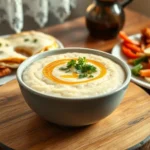
The Perfect Spanish Grits Recipe for a Cozy Morning Meal
- Total Time: 25 minutes
- Yield: 4 servings 1x
Description
Spanish grits, or gachas de maíz, are a comforting and creamy dish deeply rooted in Spanish culinary traditions. Made from stone-ground corn and slow-cooked to perfection, this dish is a staple breakfast in many Spanish households. With a smooth, velvety texture and rich flavors, these grits serve as the perfect canvas for both traditional and modern toppings. Whether paired with chorizo, jamón, or a drizzle of olive oil, Spanish grits offer a delightful taste of Spain in every bite.
Ingredients
- 1 cup stone-ground corn grits
- 3 cups water or high-quality chicken/vegetable stock
- 1 tablespoon extra virgin olive oil
- ½ teaspoon sea salt (or to taste)
- ½ teaspoon smoked paprika
- ¼ teaspoon dried thyme
- 2 cloves garlic, minced
- 2 tablespoons unsalted butter
- ¼ cup half-and-half or whole milk (optional for extra creaminess)
Optional Toppings:
- Crumbled chorizo or jamón ibérico
- Manchego cheese shavings
- Fried or poached egg
- Fresh chopped herbs (parsley, cilantro, or chives)
- Roasted vegetables
Instructions
- Prepare the liquid base: In a heavy-bottomed pot, bring the water or stock to a gentle simmer over medium heat.
- Add seasonings: Stir in olive oil, salt, smoked paprika, dried thyme, and minced garlic. Let the flavors infuse for about 2 minutes.
- Incorporate the grits: Slowly whisk in the stone-ground grits to prevent lumps from forming.
- Simmer and stir: Reduce heat to low and continue stirring frequently for 15-20 minutes until the grits thicken and become creamy.
- Finish with butter and cream: Stir in the unsalted butter and half-and-half (if using) for an extra smooth texture.
- Adjust consistency: If the grits are too thick, add a little warm milk or broth to loosen them. If too thin, continue cooking for a few more minutes.
- Serve immediately: Garnish with your favorite toppings such as crumbled chorizo, Manchego cheese, or a fried egg for an authentic Spanish touch.
Notes
- For a richer flavor: Use homemade stock instead of water.
- For a vegetarian version: Omit chorizo and use vegetable stock.
- Make-ahead tip: Store leftovers in an airtight container in the fridge for up to 3 days. Reheat with a splash of broth or milk to maintain creaminess.
- Texture fix: If the grits are too grainy, cook them longer. If too thick, add more liquid and stir well.
- Prep Time: 5 minutes
- Cook Time: 20 minutes
- Category: Breakfast
- Cuisine: Spanish
Nutrition
- Serving Size: 1 cup
- Calories: 236
- Fat: 7g
- Carbohydrates: 30g
- Protein: 14g
Keywords: spanish grits

